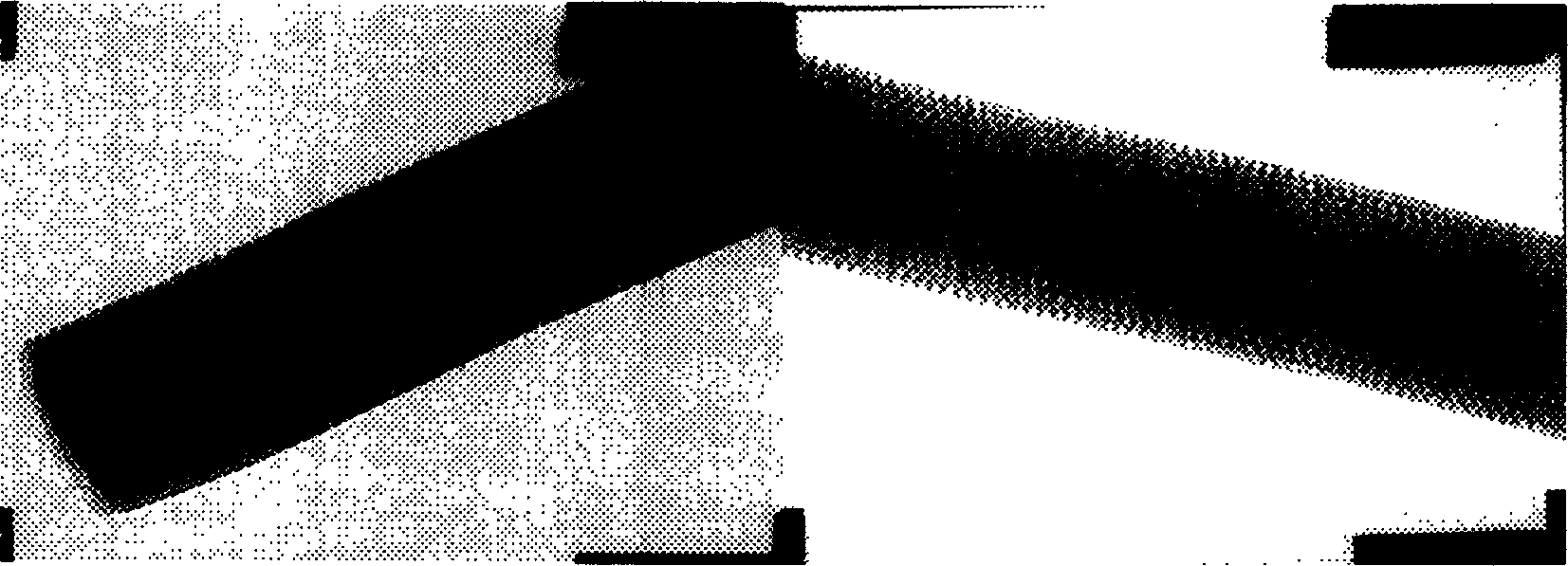Process for continuously preparing meso visual ordered hybridization silicon dioxide fiber
A technology of silica and hybridization, which is applied in the direction of silica, silica, glass manufacturing equipment, etc., can solve the problems of inability to continuously produce silica fibers, etc., and achieve good mass transfer performance and good stability.
- Summary
- Abstract
- Description
- Claims
- Application Information
AI Technical Summary
Problems solved by technology
Method used
Image
Examples
Embodiment 1
[0043] Example 1: Continuous preparation of mesoscopically ordered silica fibers
[0044] Mix 208 parts by weight of tetraethyl orthosilicate, 156 parts by weight of ethanol, 36 parts by weight of water, 0.63 parts by weight of nitric acid, and 55 parts by weight of cetyltrimethylammonium bromide, and reflux at 50°C for 90 minutes under electromagnetic stirring , to obtain light yellow transparent silica sol. The prepared silica sol was exposed to a water bath at 70° C. and heated for 2.5 hours until the viscosity increased to form a pre-gel. The silica pregel was extruded through a porous spinneret (the diameter of the hole was 20 μm), and 2×10 5 Stretch in a high-voltage electrostatic field of V / m, and obtain continuous silica fibers after drying. Place the fibers in a sintering furnace with air, and burn them at a rate of 1°C / min to 450°C for 3 hours to remove Surfactants to obtain mesoscopically ordered nanoporous silica fibers with a fiber diameter of 400nm. The result...
Embodiment 2
[0045] Example 2: Continuous preparation of mesoscopically ordered silica fibers
[0046] 208 parts by weight of tetraethyl orthosilicate, 180 parts by weight of ethanol, 30 parts by weight of water, 0.48 parts by weight of nitric acid, Brij-58{CH 3 (CH 2 ) 15 (OCH 2 CH 2 ) 20 52 parts by weight of OH} were mixed evenly, and refluxed at 60°C for 90 minutes under electromagnetic stirring to obtain a colorless and transparent silica sol. Silica fibers were prepared according to the steps in Example 1, with a spinneret hole diameter of 10 μm and a fiber diameter of 320 nm. The results of X-ray diffraction and transmission electron microscopy show that the ordered nanopores are in a cubic arrangement with a pore size of 4 nm, and the results of nitrogen adsorption show that the specific surface area of the fiber is 710 m 2 / g. like figure 2 shown.
Embodiment 3
[0047] Example 3: Continuous preparation of mesoscopically ordered silica fibers
[0048] 208 parts by weight of tetraethyl orthosilicate, 230 parts by weight of ethanol, 18 parts by weight of water, 0.6 parts by weight of nitric acid, Pluronic-123{PEO 20 -PPO 70 -PEO 20} 48 parts by weight were mixed evenly, and refluxed at 60° C. for 90 minutes under electromagnetic stirring to obtain a colorless and transparent silica sol. Mesoscopically ordered silica fibers were prepared according to the steps of Example 1, but no electric field was applied, and the fibers were formed by mechanical stretching. The spinneret hole diameter was 100 μm, the stretching rate was 30 cm / min, and the fiber diameter was 5 μm. The results of X-ray diffraction and transmission electron microscopy show that the ordered nanopores are in a cubic arrangement with a pore size of 4 nm, and the results of nitrogen adsorption show that the specific surface area of the fiber is 620 m 2 / g. like image ...
PUM
| Property | Measurement | Unit |
|---|---|---|
| pore size | aaaaa | aaaaa |
| diameter | aaaaa | aaaaa |
| specific surface area | aaaaa | aaaaa |
Abstract
Description
Claims
Application Information
 Login to View More
Login to View More - R&D
- Intellectual Property
- Life Sciences
- Materials
- Tech Scout
- Unparalleled Data Quality
- Higher Quality Content
- 60% Fewer Hallucinations
Browse by: Latest US Patents, China's latest patents, Technical Efficacy Thesaurus, Application Domain, Technology Topic, Popular Technical Reports.
© 2025 PatSnap. All rights reserved.Legal|Privacy policy|Modern Slavery Act Transparency Statement|Sitemap|About US| Contact US: help@patsnap.com



